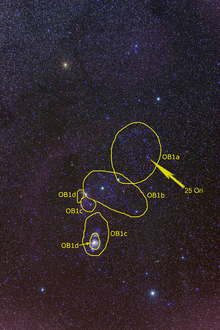- Orion OB1 Association
-
The Orion OB1 stellar association is a contingent group of several dozen hot giant stars of spectral types O and B. Associated are thousands of lower-mass stars, and a (smaller but significant) number of protostars. It is part of the larger Orion Molecular Cloud Complex. Owing to its relative closeness and complexity it is the most closely studied OB association.[1]
The Orion OB1 association consists of the following subgroups:[1][2]
- Orion OB1a - the group of stars northwest of the Orion Belt stars with an average age of about 12 million years. Within this grouping is another subgroup known as the 25 Orionis group.[3][4]
- Orion OB1b - the three bright stars ζ Ori (Alnitak), ε Ori (Alnilam), and δ Ori (Mintaka) which make up the asterism known as "Orion's Belt", and minor stars. This group has an average age of approximately 8 million years and is further subdivided into three subgroups.[5][6]
- Orion OB1c - the stars in Orion's Sword, 3-6 million years old
- Orion OB1d - the stars of the Orion Nebula and M43 (the youngest stars)
Signatures of stellar debris disk evolution have been detected in the 1a and 1b subgroups.[7][8]
References
- ^ a b Brown, A. G. A.; de Geus, E. J.; de Zeeuw, P. T.; De Geus; De Zeeuw (September 1994). "The Orion OB1 association. 1: Stellar content" (PDF). Astronomy and Astrophysics 289 (1): 101–120. arXiv:astro-ph/9403051. Bibcode 1994A&A...289..101B. ISSN 0004-6361.
- ^ Blaauw, Adriaan (1964). "The O Associations in the Solar Neighborhood" (PDF). Annual Review of Astronomy and Astrophysics 2 (1): 213. Bibcode 1964ARA&A...2..213B. doi:10.1146/annurev.aa.02.090164.001241.
- ^ Briceño, César; Hartmann, Lee; Hernández, Jesús; Calvet, et al. (June 2007). "25 Orionis: A Kinematically Distinct 10 Myr Old Group in Orion OB1a" (PDF). The Astronomical Journal 661 (2): 1119–1128. arXiv:astro-ph/0701710. Bibcode 2007ApJ...661.1119B. doi:10.1086/513087. http://iopscience.iop.org/0004-637X/661/2/1119/pdf/20301.web.pdf. Retrieved 2010-11-07.
- ^ Harper, Graham M.; Brown, Alexander; Guinan, Edward F. (April 2008). "A New VLA-Hipparcos Distance to Betelgeuse and its Implications" (PDF). The Astronomical Journal 135 (4): 1430–40. Bibcode 2008AJ....135.1430H. doi:10.1088/0004-6256/135/4/1430. http://iopscience.iop.org/1538-3881/135/4/1430/pdf/aj_135_4_1430.pdf. Retrieved 2010-11-07.
- ^ Warren, W. H., Jr.; Hesser, J. E. (June 1977). "A photometric study of the Orion OB 1 association. I - Observational data" (PDF). Astrophysical Journal Supplement Series, vol. 34, June 1977, p. 115-206 34: 115–206. Bibcode 1977ApJS...34..115W. doi:10.1086/190446.
- ^ Warren, W. H., Jr.; Hesser, J. E. (April 1978). "A photometric study of the Orion OB 1 association. III - Subgroup analyses" (PDF). Astrophysical Journal Supplement Series 36: 497–572. Bibcode 1978ApJS...36..497W. doi:10.1086/190510.
- ^ N. Calvet et al., The Astronomical Journal 129:935–946 (2005)
- ^ J. Hernandez et al., Astrophys.J. 652:472-481 (2006)
Categories:- Astronomy stubs
- Orion complex
- Stellar associations
Wikimedia Foundation. 2010.

